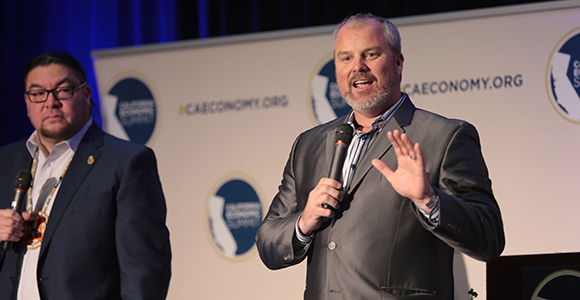
Sonoma County Supervisor James Gore (right) and Reno Keoni Franklin, chairman emeritus for the Kashia Band of Pomo Indians, opened the 2018 California Economic Summit in Santa Rosa, California Thursday. (Photo Credit: Will Bucquoy/CAFwd)
It’s no coincidence the 2018 California Economic Summit is being held this week in Santa Rosa, which suffered dramatic losses during last year’s wildfires. As more than 500 elected, civic, and private sector leaders from across the state convene to work toward elevating and renewing the California Dream, resiliency is the key word as communities continue to face disasters, both natural and manmade.
“Resiliency doesn’t mean bouncing back to where you were. That’s not a very good place to start,” said Henry Gardner, former city manager for the City of Oakland. He shepherded the city through the 1989 Loma Prieta earthquake and the 1991 Oakland firestorm. Most recently Gardner assisted Santa Rosa in its recovery efforts. “Resiliency is going beyond where you were and sustaining.”
When the Tubbs Fire swept through Sonoma, Napa and Lakes counties October 2017, Santa Rosa was ground zero, where damage was estimated at $1.2 billion, including more than 2,800 homes that amounted to five percent of the city’s housing stock. It was the second-most destructive fire in California history, only eclipsed this year by the Camp Fire currently burning north of Sacramento.
Sonoma County responded to the Tubbs Fire by establishing the Office of Recovery and Resiliency. The office leads and coordinates all recovery efforts with a strategic, long-term approach. Its priorities include developing an integrated framework for recovery as well as to develop and leverage relationships throughout the region, including community organizations, private sector leaders and neighboring jurisdictions to work collaboratively toward recovery.
“The new focus is regionalization. If we’ve got resources and data systems that we want to be put in place in our own county, why aren’t we talking to the counties that neighbor us that provide similar services,” explained Principal Analyst Christel Querijero of the Sonoma County Office of Recovery & Resiliency. “That’s a big theme. It’s also a theme across our grant applications. One of the ways we have been forced to positively interact and coordinate is through a grant workgroup – different agencies that understand that some of our issues overlap. When we allow them to broaden our request, it tells them we’re being strategic and that we’re looking outside of our boxes.”
 Resiliency is the theme throughout the Summit as participants work toward ensuring resiliency in every community. California is facing the disruptions on two fronts. Rising costs and changes in the workplace are creating social and economic dislocations. And natural disasters such as wildfires are occurring more frequently due to climate change.
Resiliency is the theme throughout the Summit as participants work toward ensuring resiliency in every community. California is facing the disruptions on two fronts. Rising costs and changes in the workplace are creating social and economic dislocations. And natural disasters such as wildfires are occurring more frequently due to climate change.
In addition, addressing poverty is one of the greatest challenges to the state, which has the highest poverty rate in the country when you factor in costs like housing. The 2018 Summit has focused its agenda on strategies to reduce income inequality, promote economic security and restore upward mobility in every region.
Breakout groups discussed and proposed strategies to tackle the issues of how to create more affordable and sustainable housing, train more skilled workers, accelerate water sustainability and resilience at a regional scale, create more livable wage jobs and support rural California. A new priority at this year’s Summit is integrating early childhood support systems across issues and sectors through a partnership with First 5 California.
Also announced today is the creation and development of the California Dream Index, a scorecard to track how the state is doing on economic mobility. Jeremy Avins, associate principal Redstone Strategy Group who also worked at The White House Office of Budget and Management, will head the effort.
CA Fwd co-chair Pete Weber explained to attendees why the Dream Index is needed, “California is generating enormous wealth, but for too many, the dream is an unfulfilled promise.”
Oscar Chavez, assistant director for the Sonoma County Department of Human Services agreed and offered his own challenge for attendees, “The history of exclusion, whether intentional or through neglect ends with us in this state in our lifetime.”
Tomorrow, the Summit will reconvene and sharpen strategies that will become the 2019 Roadmap to Shared Prosperity, the action plan for members of the Summit network for the year ahead.
 |
Read our summary of Day Two:
|

